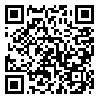Volume 13, Issue 4 (June 2019)
Qom Univ Med Sci J 2019, 13(4): 22-33 |
Back to browse issues page
Download citation:
BibTeX | RIS | EndNote | Medlars | ProCite | Reference Manager | RefWorks
Send citation to:



BibTeX | RIS | EndNote | Medlars | ProCite | Reference Manager | RefWorks
Send citation to:
Ansari M A, Gharlipour Z, Mohebi S, Sharifirad G R, Rahbar A. Effect of Education Based on the Protection Motivation Theory on Preventive Behaviors of Influenza A among High School Students in Qom City, (Iran). Qom Univ Med Sci J 2019; 13 (4) :22-33
URL: http://journal.muq.ac.ir/article-1-2377-en.html
URL: http://journal.muq.ac.ir/article-1-2377-en.html
Mohammad Ali Ansari1 

 , Zabihollah Gharlipour *
, Zabihollah Gharlipour * 

 2, Siamak Mohebi1
2, Siamak Mohebi1 

 , Gholam Reza Sharifirad3
, Gholam Reza Sharifirad3 

 , Ahmad Rahbar4
, Ahmad Rahbar4 




 , Zabihollah Gharlipour *
, Zabihollah Gharlipour * 

 2, Siamak Mohebi1
2, Siamak Mohebi1 

 , Gholam Reza Sharifirad3
, Gholam Reza Sharifirad3 

 , Ahmad Rahbar4
, Ahmad Rahbar4 


1- Department of Health Education & Promotion, School of Health, Qom University of Medical Sciences
2- Department of Health Education & Promotion, School of Health, Qom University of Medical Sciences ,gharlipourz@yahoo.com
3- Department of Medicine, School of Medicine, Qom Branch, Islamic Azad University
4- Department of Public Health, School of Health, Qom University of Medical Sciences
2- Department of Health Education & Promotion, School of Health, Qom University of Medical Sciences ,
3- Department of Medicine, School of Medicine, Qom Branch, Islamic Azad University
4- Department of Public Health, School of Health, Qom University of Medical Sciences
Abstract: (5591 Views)
Background and Objectives: Influenza is an acute viral respiratory disease. Given the importance of influenza preventive behaviors, the present study aimed at determining the effect of education based on preventive behaviors of Influenza A among the students in Qom city.
Methods: This interventional study was conducted on 200 tenth-grade male students in Qom city. The samples were assigned to two groups of intervention and control (each 100 subjects). The related questionnaires were completed by both intervention and control groups before and three months after the intervention. Training intervention consisted of two 90-minute sessions, which was performed for the intervention group. Data were analyzed using independent t-test, paired t-test, and covariance analysis.
Results: In this study, no significant difference was observed between intervention and control groups before the training intervention in terms of demographic variables as well as the components of the protection motivation theory (p>0.05). After the training intervention, a significant difference was observed in the mean scores of perceived severity, self-efficacy, reward, protection motivation, and behavior in the intervention group, as compared to the control group (p<0.05). However, there was no significant difference between the two groups in terms of the mean scores of perceived sensitivity, perceived efficacy of response, response cost, and fear (p>0.05).
Conclusion: The protection motivation theory can be effective in inducing influenza preventive behaviors. Thus, given the limited studies in this field, it seems necessary to conduct further studies in this area.
Methods: This interventional study was conducted on 200 tenth-grade male students in Qom city. The samples were assigned to two groups of intervention and control (each 100 subjects). The related questionnaires were completed by both intervention and control groups before and three months after the intervention. Training intervention consisted of two 90-minute sessions, which was performed for the intervention group. Data were analyzed using independent t-test, paired t-test, and covariance analysis.
Results: In this study, no significant difference was observed between intervention and control groups before the training intervention in terms of demographic variables as well as the components of the protection motivation theory (p>0.05). After the training intervention, a significant difference was observed in the mean scores of perceived severity, self-efficacy, reward, protection motivation, and behavior in the intervention group, as compared to the control group (p<0.05). However, there was no significant difference between the two groups in terms of the mean scores of perceived sensitivity, perceived efficacy of response, response cost, and fear (p>0.05).
Conclusion: The protection motivation theory can be effective in inducing influenza preventive behaviors. Thus, given the limited studies in this field, it seems necessary to conduct further studies in this area.
Type of Study: Original Article |
Received: 2019/01/12 | Accepted: 2019/04/17 | Published: 2019/06/15
Received: 2019/01/12 | Accepted: 2019/04/17 | Published: 2019/06/15
Send email to the article author
| Rights and permissions | |
 |
This work is licensed under a Creative Commons Attribution-NonCommercial 4.0 International License. |






